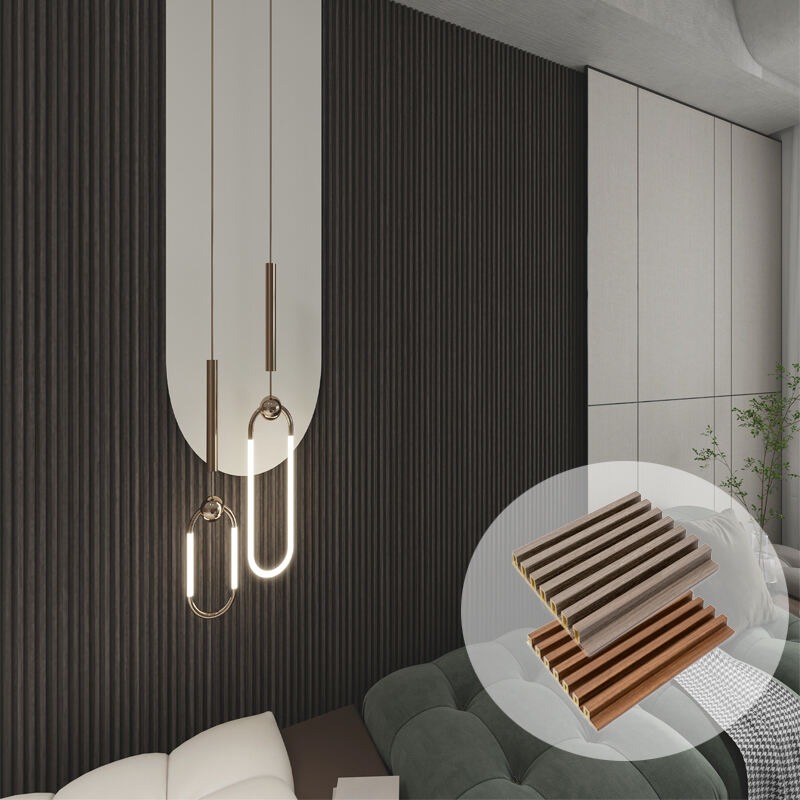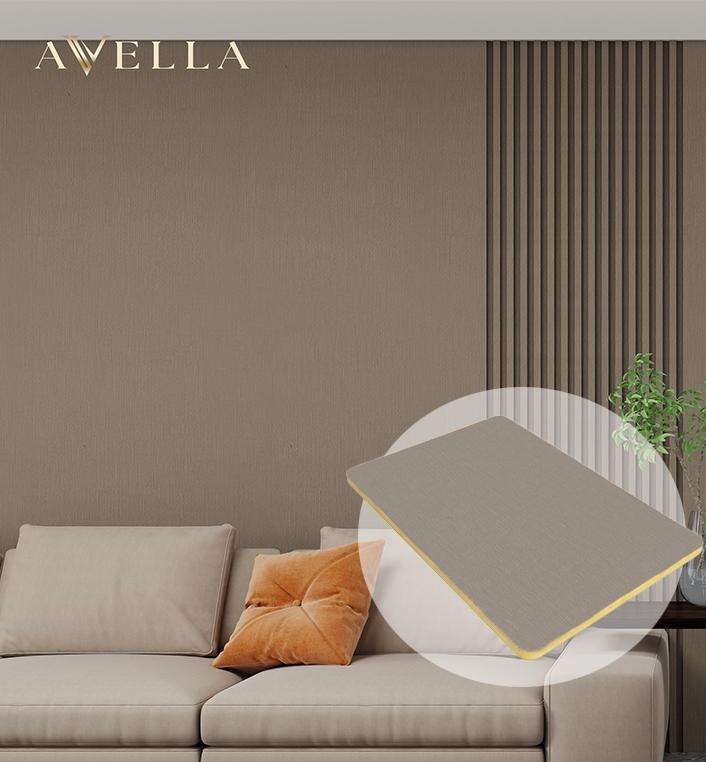يتطلب اختيار لوحة الجدار المشبكي المثالية لمشروعك المعماري مراعاة متأنية لعوامل متعددة تشمل تركيب المادة، والجماليات التصميمية، والمتطلبات الوظيفية. لقد تطورت لوحات الجدران المشبكية الحديثة لتتجاوز كونها عناصر زخرفية بسيطة، وأصبحت مكونات معمارية متطورة تؤدي غرضًا جماليًا وعمليًا في آنٍ واحد. سواء كنت تقوم بتصميم مساحة تجارية، أو واجهة سكنية، أو جدار داخلي بارز، فإن فهم الفروق الدقيقة في اختيار لوحة الجدار المشبكي يضمن نجاح مشروعك من حيث التأثير البصري والأداء الطويل الأمد. ويشمل عملية اتخاذ القرار تقييم خصائص المواد، ومتطلبات التركيب، واعتبارات الصيانة، والتوافق العام مع التصميم حسب التطبيق المحدد.

اختيار المواد والخصائص الأداء
مزايا المركب الخشبي البلاستيكي
تمثل مواد التراكب الخشبي والبلاستيكي تقدماً كبيراً في تقنية ألواح الجدران الشبكية، حيث تجمع بين المظهر الطبيعي للخشب ومتانة محسّنة ومقاومة للعوامل الجوية. وعادةً ما تتكون هذه المواد المركبة من ألياف خشبية معاد تدويرها مخلوطة براتنجات بوليمرية، مما يُنتج منتجاً يحافظ على الثبات الأبعادي ويقاوم الرطوبة والحشرات والتحلل. وتتيح عملية التصنيع توزيعاً متسقاً للألوان وأنسجة الحبيبات، مما يلغي التباينات الطبيعية التي قد تُعقّد تركيبات الخشب التقليدية. ويُشير المعماريون والمقاولون المحترفون بشكل متزايد إلى استخدام ألواح الجدران الشبكية المركبة في المشاريع التي تتطلب أداءً طويل الأمد مع متطلبات صيانة دنيا.
تتفوق سلامة الهيكلية للوح الحوائط الشبكية المركبة على البدائل الخشبية التقليدية في معظم التطبيقات الخارجية. وللتحوّلات الحرارية والتغيرات في الرطوبة والتأثيرات الناتجة عن التعرض للأشعة فوق البنفسجية تأثير ضئيل على المواد المركبة، مما يمنع التشوه والتشقق والبهتان التي تُعتبر شائعة عادةً مع المنتجات الخشبية الطبيعية. وينتج عن هذه الثباتية تقليل التكاليف الإجمالية للتركيب بمرور الوقت، نظرًا لضرورة إجراء تعديلات واستبدالات أقل طوال عمر اللوح الافتراضي. بالإضافة إلى ذلك، تتيح الخصائص الموحدة للمواد إجراء حسابات هندسية دقيقة وأداءً متوقعًا في ظل ظروف بيئية متفاوتة.
اعتبارات الخشب الطبيعي
تواصل ألواح الجدران الخشبية التقليدية ذات الفتحات الرأسية تقديم خصائص جمالية فريدة يقدّرها العديد من المصممين للتطبيقات المحددة. وتؤدي اختيارية الأنواع دورًا حاسمًا في تحديد الخصائص الأداء، حيث توفر الأخشاب الصلبة مثل السرو والتيك والإيب مقاومة أفضل للعوامل الجوية مقارنةً بالبدائل من الأخشاب اللينة. وينتج عن التباين الطبيعي في أنماط الحبوب ودرجات الألوان اهتمامًا بصريًا يصعب تكراره باستخدام المواد الاصطناعية. ومع ذلك، تتطلب الخشب الطبيعي بروتوكولات صيانة أكثر كثافة تشمل إغلاقًا دوريًا وتلوينًا وفحصًا للبحث عن علامات التلف.
غالبًا ما تؤثر اعتبارات الاستدامة البيئية في اختيار المواد الطبيعية مقابل المواد المركبة. يمكن أن يوفر الخشب المستخرج بمسؤولية من غابات مستدامة معتمدة خيارًا واعيًا بيئيًا، في حين تُعد الألواح المركبة ذات المحتوى المعاد تدويره نهجًا بديلًا للحد من الأثر البيئي. يجب تقييم عمليات التصنيع ومتطلبات النقل وخيارات التخلص في نهاية العمر الافتراضي كجزء من تقييم شامل للاستدامة. قد توفر لوائح البناء المحلية وبرامج شهادات المباني الخضراء إرشادات إضافية لاختيار المواد بناءً على معايير الأداء البيئي.
التكامل التصميمي والاعتبارات الجمالية
اختيار النمط والأثر البصري
تكوين النمط في لوحة جدارية مشبكة يؤثر بشكل كبير على الطابع المعماري العام لواجهة المبنى أو المساحة الداخلية. وتميل التوجيهات الأفقية إلى التأكيد على العرض وخلق إحساس بالاتساع، في حين أن الترتيبات الرأسية تجذب العين نحو الأعلى ويمكن أن تجعل المساحات تبدو أطول. أما الأنماط القطرية فتُدخل حركة بصرية ديناميكية ولكنها تتطلب مراعاة دقيقة لخطوط النظر وزوايا الرؤية لتحقيق التأثير الأمثل. ويؤثر التباعد بين عناصر الشبكة الفردية على المظهر الجمالي والأداء الوظيفي معًا، حيث يوفر التباعد الأضيق خصوصية أكبر وحماية أفضل من عوامل الطقس، على حساب التهوية ومرور الضوء الطبيعي.
تُفضل الاتجاهات المعمارية المعاصرة الأنماط الهندسية النظيفة التي تتماشى مع فلسفات التصميم البسيط، مع توفير فوائد وظيفية. إن التفاعل بين المساحات الصلبة والفراغات يخلق فرصًا لتأثيرات إضاءة درامية، خاصة عندما تكون الألواح مضاءة من الخلف أو موضوعة بحيث تمتص أنماط الظلال المتغيرة على مدار اليوم. ينبغي أن تأخذ عملية اختيار الألوان بعين الاعتبار التأثير البصري الفوري والمظهر الطويل الأمد، نظرًا لأن المواد والأسطح المختلفة تتقدم في السن بمعدلات مختلفة. يتطلب تنسيق ألوان ألواح الجدران المشبكة مع عناصر المبنى الأخرى فهم كيفية استجابة المواد المختلفة للتعرية والتعرض للأشعة فوق البنفسجية على مدى فترات طويلة.
إرشادات الحجم والنسبة
يُعد التدرج المناسب لعناصر لوحة الجدار المشبكي بالنسبة لأبعاد المبنى الكلية أمرًا ضروريًا لضمان دمج معماري متناسق. يمكن للمباني الكبيرة أن تستوعب فواصل مشبكية أوسع وعناصر فردية أكثر بروزًا، في حين تستفيد المباني الأصغر من أنماط أدق وأكثر رقة تحافظ على العلاقات المتناسبة مع المقياس البشري. ويؤثر بُعد الرؤية على كثافة النمط المدركة، حيث تتطلب الألواح المصممة للفحص القريب اعتبارات تصميم مختلفة عما هو مخصص للرؤية من مستوى الشارع أو من مسافات أكبر. ويمكن للبرمجيات الاحترافية للتصميم أن تساعد في تصور كيفية ظهور التشكيلات المختلفة للشبكات عند مقاييس وزوايا رؤية متعددة.
مبادئ التصميم المندمج تسهل كل من التثبيت الأولي والتعديلات المستقبلية أو التوسعات. أبعاد اللوحات الموحدة وأنظمة الاتصال تمكن من عمليات البناء الفعالة مع الحفاظ على مرونة التصميم. يجب أن يتم تحديد العلاقة بين وحدات لوحة الجدران الشبكية وأنظمة المبنى الأخرى مثل النوافذ والأبواب والعناصر الهيكلية في وقت مبكر من عملية التصميم لتجنب تضارب التنسيق. يمكن أن تساعد أنظمة نمذجة معلومات البناء في تحديد مشاكل التكامل المحتملة قبل بدء البناء ، مما يقلل من التعديلات والمؤخرات المكلفة في الميدان.
طرق التثبيت والمتطلبات التقنية
أنظمة التثبيت والدعم الهيكلي
يتطلب التركيب السليم للوح الحائط الشبكي فهم متطلبات الأحمال الإنشائية واختيار أنظمة التثبيت المناسبة حسب التطبيق المحدد. يجب أخذ أحمال الرياح والتمدد الحراري والقوى الناتجة عن التصادم المحتمل بعين الاعتبار عند تحديد طرق التثبيت ومتطلبات المسافات بين نقاط التثبيت. توفر أنظمة التثبيت المخفية مظهراً جمالياً نظيفاً، ولكن قد تتطلب دعماً إنشائياً إضافياً أو أجهزة تثبيت خاصة. أما أنظمة التثبيت الظاهرة فتوفر سهولة أكبر في التركيب والوصول للصيانة، لكنها تتطلب اختياراً دقيقاً لمواد وأسطح الأجهزة المستخدمة لتتناسب مع التصميم العام.
يؤثر إعداد الطبقة الأساسية بشكل كبير على أداء اللوحة وشكلها على المدى الطويل. يجب أن توفر المواد الخلفية الهيكلية دعماً كافياً للأحمال المتوقعة مع التكيف مع الحركة الحرارية دون نقل الإجهاد إلى لوحات الشبكة. ويمنع إدارة الرطوبة خلف الألواح تدهور كل من الألواح والهيكل الداعم، مما يستدعي تصميمًا صحيحًا للدرزات المانعة لتسرب المياه، والتصريف، والتهوية. قد تؤثر متطلبات كود البناء المتعلقة بمقاومة الحريق، والأداء الزلزالي، والامتثال للإتاحة على طرق التركيب واختيار الأجهزة.
الإغلاق ضد عوامل الطقس وإدارة الرطوبة
تحمي أنظمة إدارة الرطوبة الفعالة لوحات جدران الشبكة والعناصر البنائية الكامنة وراءها من أضرار تسرب المياه. تقوم طبقات التصريف الواقعة خلف اللوحات بتوجيه المياه بعيدًا عن العناصر الإنشائية مع السماح بتدفق تهوية يمنع تراكم الرطوبة. إن اختيار مادة السد والتقنيات المستخدمة في تطبيقها تؤثر بشكل كبير على المقاومة طويلة الأمد للعوامل الجوية، حيث توفر مواد سد الزجاج الهيكلي أداءً أفضل مقارنةً بالمواد السداسية القياسية. ويمنع الفحص الدوري والصيانة لأنظمة الختم الجوي من تطور المشكلات البسيطة إلى مشكلات هيكلية كبيرة.
يمكن أن يؤدي التوصيل الحراري من خلال أنظمة التثبيت إلى حدوث مشاكل التكاثف في المباني الخاضعة للتحكم المناخي. وتُقلل مواد العزل الحراري وتقنيات الفصل الحراري من انتقال الحرارة مع الحفاظ على السلامة الإنشائية. ويجب تنسيق أنظمة الحواجز البخارية بعناية مع تركيب لوحات الشبكات لمنع انتقال الرطوبة مع السماح بالتهوية الضرورية. وتتحقق عمليات اختبار وتأهيل الغلاف البنائي من التثبيت الصحيح وأداء نظم الحماية الجوية المتكاملة قبل احتلال المبنى.
متطلبات الصيانة وعوامل العمر الافتراضي
بروتوكولات التنظيف والفحص الروتينية
إن إعداد بروتوكولات صيانة شاملة يُطيل عمر ألواح الجدران الشبكية الخدمي ويحافظ على المظهر الجمالي طوال فترة تشغيل المبنى. تتطلب المواد المختلفة للوحات أساليب ومنتجات تنظيف محددة لتجنب التلف أو التدهور المبكر. وعادةً ما تحتاج الألواح المركبة إلى صيانة أقل تكرارًا مقارنةً بالبدائل المصنوعة من الخشب الطبيعي، ولكن التنظيف الدوري يزيل الأوساخ والمخلفات والملوثات البيئية المتراكمة التي قد تؤثر على المظهر والأداء. ويجب استخدام أنظمة الغسيل عالي الضغط بحذر لتفادي دفع الماء خلف الألواح أو إتلاف التشطيبات السطحية.
تحدد جداول الفحص المنتظمة المشاكل المحتملة قبل أن تتطلب إصلاحات مكلفة أو استبدال الألواح. يجب تقييم سلامة المثبتات، وحالة مادة السد، ومحاذاة الألواح خلال دورات الصيانة الروتينية للمبنى. يوفر توثيق نتائج الفحص والأنشطة الصيانية معلومات قيمة للمطالبات بموجب الضمان، ويساعد على تحديد ترددات الصيانة المثلى للظروف البيئية الخاصة. يمكن لمقاولي الصيانة المحترفين الذين لديهم خبرة في أنظمة ألواح الجدران الشبكية تقديم خدمات متخصصة تحافظ على ضمانات الشركات المصنعة مع ضمان الأداء الأمثل.
اعتبارات الاستبدال والترقية
تسهل أنظمة الألواح الجدارية الشبكية المعيارية استبدال الأجزاء التالفة أو البالية بشكل انتقائي دون التأثير على المناطق المحيطة. ويضمن الاحتفاظ بمخزون من الألواح الاستبدالية تطابق اللون والتشطيب للإصلاحات المستقبلية، حيث يمكن أن تؤدي الاختلافات في التصنيع إلى فروق ملحوظة في المظهر. قد توفر التطورات التكنولوجية في مواد الألواح ونظم التركيب فرصًا لتحسين الأداء خلال مشاريع التجديد الكبرى. وينبغي أن يأخذ تحليل التكلفة والعائد لخيارات الاستبدال مقابل الترميم في الاعتبار العمر الافتراضي المتبقي، ومتطلبات الصيانة، والتوافق مع نظم المبنى الحالية.
تختلف خيارات التخلص من الألواح في نهاية عمرها الافتراضي أو إعادة تدويرها بشكل كبير بين مواد الألواح المختلفة، وينبغي أخذ ذلك بعين الاعتبار أثناء اختيار المادة الأولية. قد تكون الألواح المركبة التي تحتوي على مواد معاد تدويرها مؤهلة للحصول على اعتمادات المباني الخضراء، إلى جانب توفير مزايا في التخلص مقارنةً بالمواد التقليدية. كما أن توثيق مواصفات المواد وتفاصيل التركيب يدعم تخطيط التجديد المستقبلي ويساعد على ضمان التوافق بين المكونات الأصلية وأخرى بديلة.
الأسئلة الشائعة
ما العوامل التي تحدد عمر ألواح الجدران الشبكية؟
يعتمد عمر ألواح الجدار الشبكي بشكل أساسي على اختيار المواد، والظروف البيئية، وممارسات الصيانة. تدوم المواد المركبة عادةً من 20 إلى 30 عامًا مع الحد الأدنى من الصيانة، في حين قد تحتاج الألواح الخشبية الطبيعية التي تم صيانتها بشكل جيد إلى الاستبدال أو تجديد كبير بعد 10 إلى 15 عامًا. يؤدي التعرض للإشعاع فوق البنفسجي، والرطوبة، وتقلبات درجات الحرارة، والملوثات إلى تسريع تدهور المواد، مما يجعل التقييم البيئي أمرًا بالغ الأهمية للتنبؤ بطول العمر الافتراضي. يمكن للصيانة المنتظمة، بما في ذلك التنظيف، والتفتيش، والإصلاحات في الوقت المناسب، أن تُطيل بشكل كبير من عمر خدمة الألواح بغض النظر عن اختيار المادة.
كيف تؤثر لوائح البناء على تركيب ألواح الجدار الشبكي
تنظم لوائح البناء تركيب لوحات الجريل من خلال متطلبات الدعم الهيكلي، ومقاومة الحريق، والامتثال للإتاحة، والكفاءة في استهلاك الطاقة. تحدد حسابات أحمال الرياح أنظمة التثبيت المطلوبة والدعم الهيكلي، بينما قد تحد الشروط الخاصة بالحريق من خيارات المواد أو تتطلب أساليب تركيب محددة. وتضمن متطلبات الإتاحة وجود مسافات كافية وعبورًا آمنًا حول تركيبات الألواح. وتتناول شروط الكفاءة في استهلاك الطاقة بشكل متزايد ظاهرة التوصيل الحراري (الجسر الحراري) والتسرب الهوائي عبر مكونات الغلاف الخارجي للمبنى، بما في ذلك الألواح الزخرفية. ويضمن مراجعة التصميم الاحترافية الامتثال للوائح مع الحفاظ على الأداء الجمالي والوظيفي المطلوب.
ما الصيانة المطلوبة لأنواع مختلفة من مواد الألواح
تختلف متطلبات الصيانة بشكل كبير بين مواد الألواح الشبكية. تتطلب الألواح المركبة عادةً تنظيفًا سنويًا وفحصًا دوريًا للمسامير والمواد السداسية، دون الحاجة إلى إعادة تشطيب خلال عمرها الافتراضي. تحتاج الألواح الخشبية الطبيعية إلى صيانة أكثر كثافة تشمل التلوين أو التحميل الدوري، والتفتيش المنتظم على علامات التلف أو أضرار الحشرات، واستبدال لوحات فردية عند الضرورة. قد تتطلب الألواح المعدنية منتجات تنظيف متخصصة وفحصًا دوريًا للتآكل، خاصة في البيئات الساحلية أو الصناعية. يُحسّن إعداد جداول صيانة مناسبة بناءً على توصيات الشركة المصنعة والظروف البيئية المحلية من الأداء والمظهر على المدى الطويل.
كيف تؤثر الظروف البيئية على اختيار المواد
تؤثر الظروف البيئية تأثيراً كبيراً على أداء مواد لوحة الشبكة ويجب أن توجه قرارات الاختيار. فالبيئات الساحلية المعرضة للهواء المالح تفضل المواد المركبة أو المعالجة خصيصاً بدلاً من الخيارات الخشبية القياسية. وتستفيد المناطق ذات التعرض العالي لأشعة الشمس من المواد المزودة بثوابت للأشعة فوق البنفسجية أو أصباغ مقاومة للبهتان. وتحتاج المناطق التي تتسم بتغيرات شديدة في درجات الحرارة إلى مواد ذات معامل تمدد حراري منخفض لتقليل الحركة والضغط الناتج. كما قد تؤدي البيئات الحضرية الملوثة إلى تسريع تدهور المواد، مما يجعل متطلبات الصيانة وسهولة التنظيف من معايير الاختيار المهمة. وتوفر بيانات الاختبار الخاصة بالمناخ والخبرة المحلية مع مختلف المواد إرشادات قيمة لاتخاذ قرارات اختيار المواد.

